Fieldstone School THE OUR KIDS REVIEW
The 50-page review of Fieldstone School, published as a book (in print and online), is part of our series of in-depth accounts of Canada's leading private schools. Insights were garnered by Our Kids editor visiting the school and interviewing students, parents, faculty and administrators.
Our Kids editor speaks about Fieldstone School
Introduction
Families don’t often think of how a school was founded, or why, when considering their enrolment options. And, to be sure, it’s not always clear why they might. In many cases, a school’s origins may be interesting, but largely inconsequential to the current life of the institution. The oldest private schools seem to have emerged from the soil, as with Eton or, in Canada, Upper Canada College (UCC) and King’s-Edgehill. Those schools, famed as they are, were formed in a different historical context, and based in a different set of concerns. UCC, for example, was founded by Sir John Colborne, Lieutenant Governor of Upper Canada. Colborne didn’t stay long, though of course he didn’t intend to. He wasn’t interested in working with children or running a school, but rather in creating a non-denominational institution that would supply the colonies with leaders, educators, and merchants.
The fact is, however, that the vast majority of private and independent schools in Canada are younger, by far, and derive from impulses that are actually very relevant to what they represent and what they offer today. Fieldstone is a prime example of that. David Butcher founded it in the late 1990s. After more than a decade of teaching, he became disillusioned with what the educational system was offering, and frustrated by the things he felt were not being offered. He had come to the profession with a passion to teach, to work with young people, and to help them realise their aspirations. Educational institutions, in his experience, weren’t always serving that passion. He decided to step away from it and to pursue other interests, though even then he never lost his interest in education and what he felt, in a better setting, it could ultimately do.
And then he encountered the writing of E. D. Hirsch, an educator and literary critic who spent the bulk of his career at the University of Virginia. In the 1980s Hirsch began developing a curriculum called Cultural Literacy and Core Knowledge, which was, at least in some senses, a back-to-basics approach to primary and elementary education. It was a reaction to what was happening in education at that time, namely a move toward more progressive forms of instruction, and away from the tried and true. He wasn’t alone—this was the time of Allan Bloom’s book The Closing of the American Mind—as concerns about how education was changing were simply in the air.
Hirsch founded the Core Knowledge Foundation in 1986, and by the early 1990s he was publishing the Core Knowledge series of teacher texts. Through those programs Hirsch expressed his belief that the reason schools weren’t having the success they could, or should, was because they weren’t teaching children what they ultimately needed to know. They weren’t creating a strong foundation, he suggested, or acquainting them with the content knowledge they would need to be successful in secondary education and beyond. One of the things that differentiated Hirsch’s curriculum was how its outcomes were expressed: they outlined what a student should know, rather than the skills she should have.
In 1996 Hirsch wrote what would become a highly influential book in North America: The Schools We Need and Why We Don’t Have Them. He wrote that curricula that promote only critical thinking skills over content were not only a disservice to learners, they also were one of the causes of widening gender, cultural, and economic disparities. “Differences in reading ability between five-year-olds and eight-year-olds,” wrote Hirsch, “are caused primarily by the older children’s possessing more knowledge, not by the differences in their memory capacities, reasoning abilities, or control of eye movements.” In the early 1970s, Hirsch was teaching at the University of Virginia and studying reading instruction. He noticed that children from poorer households struggled to read a passage about the surrender of Robert E. Lee not because they couldn’t recognize the letters and words, but because they lacked the necessary background knowledge on his role within the American Civil War. Rates of literacy were dependent, he concluded, as much on our prior knowledge as they were on symbol recognition. One commenter wrote that reading “is a matter of decoding context: the surrounding matrix of things referred to in the text and things implied by it.”
While rote knowledge was increasingly denigrated as a means of instruction, Hirsch suggested that, in fact, it was essential, and that pure content—times tables, names, dates, definitions—was necessary for children to grow a facility with higher-order concepts and a more substantial, authentic engagement with them. In his 1983 book, Cultural Literacy, he included an appendix listing 5,000 facts, words, and phrases that he felt every American child should know. The appendix became a sensation almost independently of the book, which was a bestseller. The concept struck a chord with educators and parents alike, as did his formulation of cultural literacy. “Cultural literacy,” wrote E. D. Hirsch, “is the oxygen of social intercourse.” Later he commented that “to be culturally literate is to possess the basic information needed to thrive in the modern world.” He felt that literacy is the essential aim of education—or at least that it should be—though, again, he didn’t think of literacy simply as sign recognition, but as facility with a common body of knowledge. He said that “literate culture is the most democratic culture in our land: it excludes nobody; it cuts across generations and social groups and classes; it is not usually one’s first culture, but it should be everyone’s second, existing as it does beyond the narrow spheres of family, neighborhood, and region.”
In Hirsch, Butcher had found a kindred spirit, one who validated his own conception of how best to teach students and maximize their academic success. “He felt that he could do more,” says Ginie Wong, the current head of school, of Butcher’s impulses. “He felt, and he still feels, that students aren’t as challenged as they should be in most schools. That the teachers aren’t as passionate as they should be. And that’s why he wanted to open a school of his own.”
In 1997, Butcher created Fieldstone Day School in order to provide an environment that matched those instructional ideals. He based the school’s curriculum on the best of Hirsch’s Core Knowledge curriculum and also set about Canadianizing the topics included within it, including the addition of French. In so doing, he created Global Knowledge, a new program that would instill students with sufficient self-esteem to allow them to confidently master difficult academic challenges amid a caring, warm, and supportive environment. The name—Global Knowledge—was chosen presumably as a nod to Hirsch’s curricular sequencing, though also to signal a departure from it. This wasn’t Core Knowledge, but rather a sequence of learning that was inspired by it, and built of like convictions. (Similarly, beginning in 2009, public educators in England began adapting Hirsch’s work to the British school curriculum.)
While the school has grown over the years, those concepts remain at the heart of the Fieldstone program. To have success in math, students need to know their times tables; to understand music, they need to have a sense of where it comes from and how it’s changed; to understand history, they need to have a basic facility with key names, dates, and events; and so on. Butcher believed, too, that students need to be able to interact well with others, and to build character in concert with academics.
All of that is what continues to distinguish the Fieldstone program: a faith in the value of canonical knowledge and cultural literacy, and a commitment to the development of character and esteem. While other programs have been adopted over the years—Saxon Math, the Cambridge Assessment, the Duke of Edinburgh’s Award—they all build and strengthen the delivery of the school’s foundational principles.
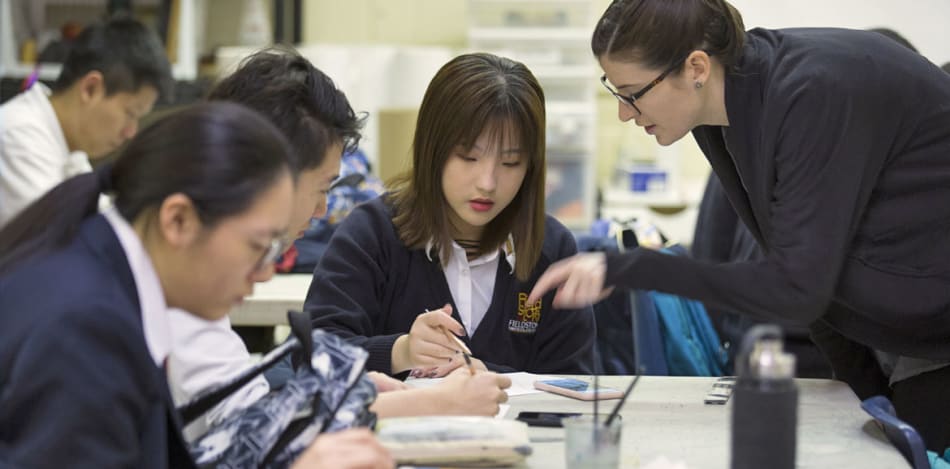
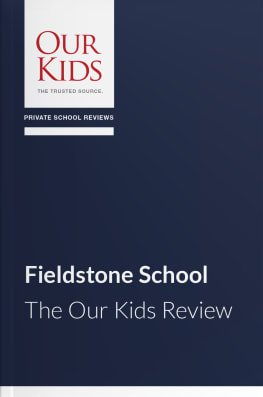
Key words for Fieldstone School: Challenge. Creativity. Character.
Basics
Fieldstone School is a private, co-educational and non-denominational day school for students from JK through Grade 12. It comprises the Fieldstone Day School (JK through Grade 8) and Fieldstone King’s College School (Grades 9 through 12). Both, while having different names and somewhat different identities, are housed in a single building and share resources, including administration, a library, cafeteria, and athletics facilities.
When it began, Fieldstone operated out of a church basement in midtown Toronto with a handful of students drawn from a group of families who saw the value in Butcher’s leadership, approach, and the developing Global Knowledge curriculum. The school population continued to grow; as enrolment increased, the school moved several times to increasingly larger spaces. In 2001, Fieldstone began to occupy its present-day facility in a leased, former Toronto District School Board (TDSB) high school in North York. The school sits on a sizable property, something that Wong rightly notes is rare for schools in the area. In most schools, space—indoors and out—is at a premium. Here, the spaces are ample, comfortable, and allow for dedicated program areas, as well as appropriate divisions between the primary, elementary, and secondary levels.
Ginie Wong first came to Fieldstone as a tutor more than two decades ago, and has occupied a growing role ever since, including teacher and administrator, and ultimately becoming head in 2018. Throughout, she’s worked closely with David Butcher, essentially apprenticing with him through what has been, for all intents and purposes, the entire life of the school. She is intent on continuing the school’s vision and mission as defined by Butcher while also putting her own stamp on its academics, music, sports, and co-curriculars as the school evolves to meet the needs of current students. As befits a small school, Wong works closely with teachers and other administrators. Many of them have also been at the school for the better part of their careers, providing a real sense of continuity.
When we visited, there was a busy, happy hum and welcoming atmosphere throughout the school. Set back from a major street with secure and safe vehicular access through a side street, the school’s front walkways are housed behind fencing that contributes to the park-like feel and its gardens. The school acts as a community hub; youth theatre groups rehearse in the facility in the evenings, youth sports leagues play in the fields on weekends, and camps run in the summer months. Fieldstone enjoys all the benefits of a campus-like setting, including extensive sports fields shielded from public view at the rear of the building. Classrooms feature high ceilings, and expansive windows face east/west and look out on greenery. The school’s proximity to major arteries and bus lines, including connections to the subway, offer older students and parents flexibility in transit options. Fieldstone provides supervised pre- and after-school care for an additional fee.
Fieldstone King’s College was created in order to extend the program that Butcher had developed for the primary and elementary grades. The Core Knowledge approach is based on a desire to teach students through classical, canonical knowledge while making it relevant to contemporary learners. The international feel is substantial, something that is seen as a strength of the program. Students arrive from Asia, Europe, and South America. Conversely, the school has established partnerships with secondary level institutions—they refer to them as sister schools—in China, Mexico, Cameroon, and Japan.
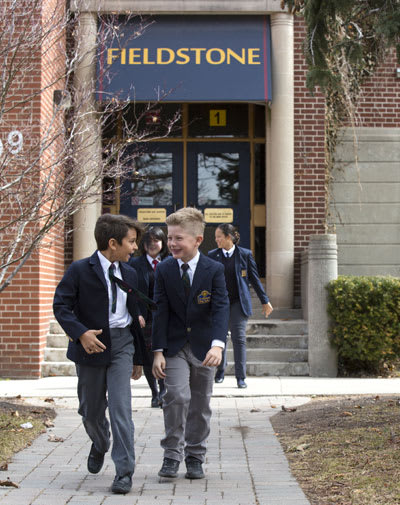
Academics
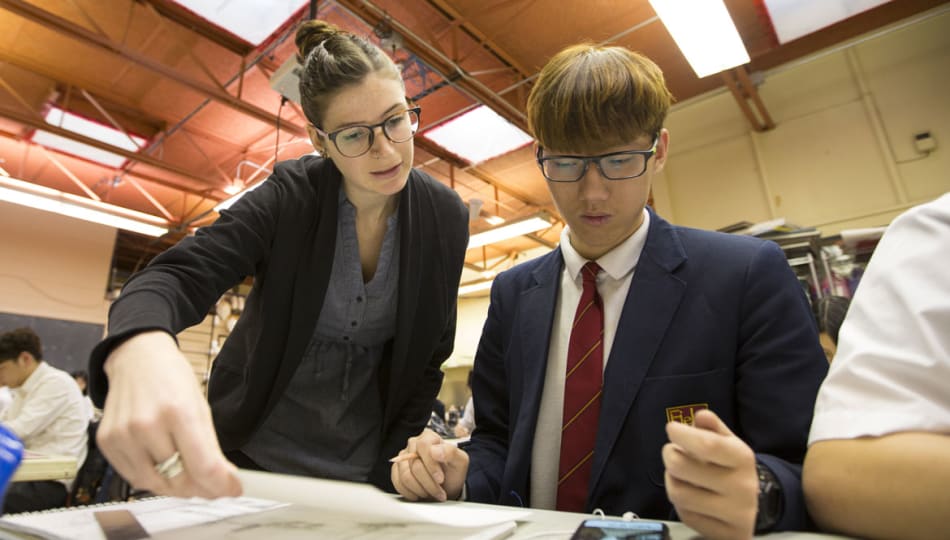
While all grade levels follow the Ontario curriculum (students who graduate from the high school program earn the Ontario Secondary School Diploma), academics are inflected with the program of study that Hirsch described, and which Butcher developed for Fieldstone specifically. Canonical knowledge and cultural literacy, particularly as Hirsch defined it, are key aspects.
Art classes, for example, begin with appreciation. Students learn about the history of art by using their own work as a means of engaging with it, often in charming ways. When we toured, Devon Henderson, an art instructor, showed us some paintings that a class of elementary students had done in the style of the cave paintings at Lascaux. They had learned about the techniques used there, and the style of representation, and used them to create their own images. Learning this way isn’t just mimicry—some students took their work further by outlining their images in glow-in-the-dark paint. They had clearly been speaking not only about what the paintings showed, but also where they were (in a cave without lighting). Students, then, found a modern solution to the problem of how the images could be viewed. Similarly, in the hallway were pieces that the JKs had done in the style of Piet Mondrian, something that formed the basis for an interaction with primary colours.
That means of delivery—relating student work to the traditions, yet within a contemporary context—is a constant throughout the arts programs. Music performance includes an appreciation of famous composers and their techniques. Every day begins with Morning Music, a half hour of classical music played throughout the halls and classrooms. Morning Music intends to informally acquaint students with the canon of western musical works, and to begin helping students distinguish between the musical eras, from medieval plainchant to recent compositions. Music appreciation is augmented through ancillary exercises.
All students learn to play the violin, along with music theory and note reading. Students in JK to Grade 3 also take part in the Orff music program. As they grow as musicians, students can join a number of ensembles (some are open to all, while others require an audition). They certainly don’t pull any punches, but rather students dive right into an engagement with significant music. Staples of the orchestra are Karl Jenkins’ Palladio and Bach’s Brandenburg Concerto no. 3. There are also some nice incentives to ongoing participation, including an opportunity to play the American and Canadian anthems at a Blue Jays baseball game each year.
Fieldstone’s vibrant dramatic arts program focuses primarily on the study and performance of Shakespeare. It can sound grand—and to its credit, the school doesn’t shy away from the heft of it all. They present an entire Shakespeare play each year—the full-text—and are as apt to produce King Lear as they are Romeo and Juliet.
Embedded in the school day, several times a week, is a period designed specifically for student-chosen enrichment clusters. Distinct from co-curriculars, these mixed-grade activities are considered an integral component of a Fieldstone education and important in building the Fieldstone community. Enrichment clusters focus on project creation, and students, with guidance, help to decide which clusters the school will offer. In the past several years, the clusters have included ‘comic book creation,’ ‘crazy for crochet,’ ‘eco-chic’ (students use recycled materials to make their own fashion pieces), ‘songwriters’ circle’ (students re-imagine their favourite song lyrics), and ‘centre stage’ (students work on a production that includes dancing). At a culminating showcase, students present their collaborative projects to an audience of family and the rest of the school population.
On the macro level, over the life of the school, Butcher brought to it texts and assessments that support the core impulse—most notably, spiral curriculum, Saxon Math, and Cambridge Education and Examinations.
Spiral curriculum
Spiral curriculum was developed in the 1960s by Jerome Bruner. It is based on the belief, Bruner wrote, that any subject—no matter how complex—“can be taught in some intellectually honest form to any child at any stage of development.” In his model, students revisit topics at intervals over the course of the school year, each time adding more complex or higher-order elements. In this way, new learning retains a relationship to key antecedents, while also giving students time—the spaces in between intervals—to internalize what they’ve learned. Each time students revisit a topic, they both reinforce what they’ve learned and add to it. Bruner also believed learning should be driven by student curiosity, and that the best learning occurs when students find the material engaging and appealing.
Saxon Math
In Saxon Math, students learn the concepts, though they are also required to gain a facility with the knowledge they need in order to apply them efficiently. Learning the times tables and memorizing formula are both required in Saxon Math, and the success of students who follow the program bear out the efficacy of the approach.
The program was developed by John Saxon who, in the 1980s and 1990s, was a vocal opponent of the reforms being introduced into the math curriculum in the United States. In time, he developed his own course of study, one that prized incremental development of the core concepts coupled with continuous review. Large concepts are broken down into manageable pieces, and review is built on practice.
Critics of Saxon’s method find it too drill-oriented, with less of a focus on practical application—but no doubt he found those criticisms to be, well, compliments. That’s what he felt was necessary to learn. And while incremental development and practice were key, he also introduced application, but only after the concepts were mastered.
Unable to find a publisher, Saxon self-published textbooks based on his method. Their popularity grew over time, something that continues to this day. Many private and independent schools in Canada—Hudson College is another in the Greater Toronto Area—use it to great success, as evidenced by national metrics.
Cambridge Education and Examinations
Fieldstone is the only school in Toronto that offers a dual Cambridge-Ontario curriculum, following the Cambridge curriculum in English, math, science, information and communications technology (ICT), and, as of June 2018, the new Cambridge Global Perspectives (Elementary) program.
The Cambridge curriculum is better known in the UK and not always familiar to parents when they begin their search for a private school. It is geared toward individualized learning that allows students to move through the curriculum at their own pace. “I didn’t know anything about Cambridge education before I visited Fieldstone,” says a current parent of the school, “and it sounded pretty rigorous to me, although it has been around for eons and used around the world.” That said, he feels it is integrated well. Despite sounding quite grand, he says his son “doesn’t find it scary at all, and doesn’t mind the testing and understands it’s a way to let him achieve his goals.”
Cambridge Assessment was founded at the University of Cambridge in 1858, so it has a long pedigree that is based, of course, in an even longer one. The University of Cambridge dates to 1209, and was given royal assent by King Henry III in 1231. It’s the second oldest university in the English-speaking world, with a reputation to match its duration. Its list of alumni reads like a who’s who of English arts and sciences, including Christopher Marlowe, Charles Darwin, Ludwig Wittgenstein, Stephen Hawking, and many, many others. Whatever Cambridge has done over the years, for the most part, it has done it very, very right.
Cambridge Assessment was created to further the reach of the university and the academic standards that had been developed there. It provides a framework for students to develop a range of transferrable skills, including expository writing, practical examinations, oral examinations, case studies, written examinations, and course work.
Today, it has been adopted by more than 10,000 schools in over 160 countries. It is a curriculum—teachers teach through it—as well as a rigorous course of assessment. While students use Cambridge texts and in-class resources, it’s the exams that are the most conspicuous aspect of the program. Students write standardized, non-competitive Cambridge Progression Tests and Checkpoint examinations that measure achievement in Cambridge subjects on an international scale. Participating schools, as at Fieldstone, are required to have examination spaces that meet the standards set out by the Cambridge governing body. “That includes how far the desks should be apart, what time the exam should start and end, where the exams should be stored,” says Wong. Walls are bare and timing is standardized, as are the requirements of invigilation. Exams are then marked externally, at Cambridge. “There are specific rules, though Cambridge would allow extra time, or for a quiet writing area” for students who have a diagnosed learning challenge that requires those kinds of supports. Students in Grades 5 and 8 write standardized Checkpoint exams that are assessed at the University of Cambridge.
Many families see the benefit in that standardization—children who complete the Cambridge Assessment know precisely where they stand relative to students not only in Canada but around the world, and they attain objective, international benchmarks. University admissions offices recognize the rigour and the standards as well.
The Cambridge curriculum is updated yearly, according to the Cambridge Schools framework, and the Cambridge system provides rigorous training for its teachers worldwide. The combination of a robust online presence and in-person conferences keep Cambridge educators abreast of evolutions in the Cambridge curriculum.
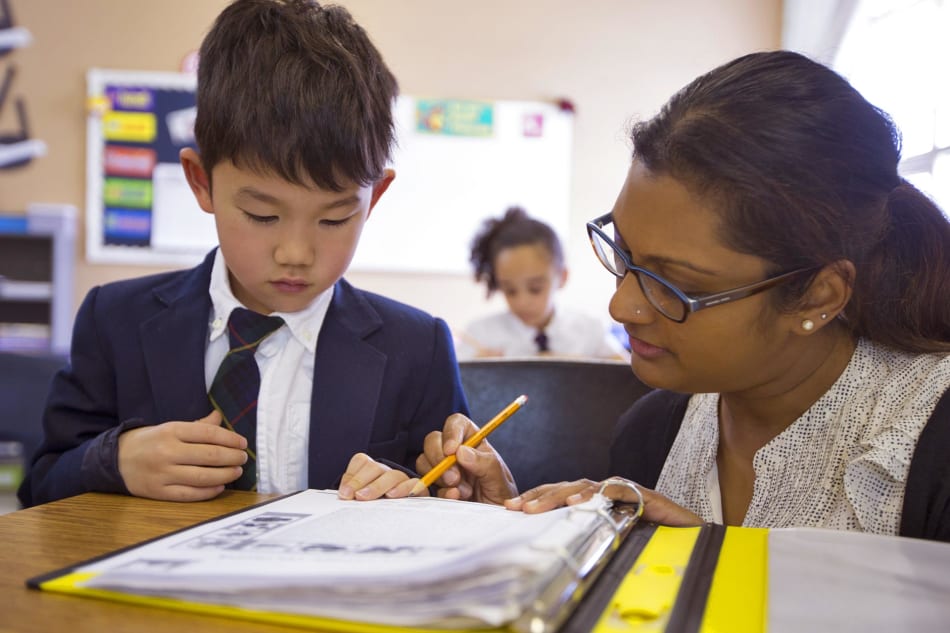
Academic environment
“Through challenging the students to achieve a higher level,” says Wong, “they begin to see they are capable of doing things they originally thought they couldn’t do. Thus they secure greater self-confidence and are able to take on new challenges without fear,” all the while building a sense of their own competence. While Butcher no longer has a daily interaction with the school, nor a formalized role within the administration, he nevertheless is active within it and his presence throughout the school is keenly felt. Fieldstone attracts teachers who, like Butcher, feel that there is a better way of doing things and dedicate themselves to helping provide it.
The teaching style is interactive, as opposed to an exclusively didactic lecture style, says Leanne Martin, a former teacher at the school and now assistant head. Teachers move freely around the classrooms, which are configured to encourage students to engage equally with teachers and peers. “Especially with the Cambridge curriculum, it’s teacher-led,” says Martin, “and depends on the teachers’ preparation and lesson planning, but also on student participation. So as teachers, the challenge is for us to really ensure there’s a high level of student engagement.” Given Fieldstone’s definable character vis-à-vis the Cambridge instructional program, the early immersion in music and Shakespeare, and the focus on the individual child, teachers need to be truly aligned with Fieldstone’s vision.
That’s an important consideration for parents. One told us that “I realize there’s no promise teachers will stay over the time my child is at the school, and the reality is that some teachers may not fit in [just like some students], but I want some assurance they share, at the very least, the same vision I have for my child.”
Sue Johnson is in charge of teacher recruitment. She explains that, as is common with many private schools, Fieldstone receives a large number of applications, but in assessing candidates, she tends to hire teachers who are only one or two years removed from their teacher training. While this approach may seem counterintuitive (as it might seem logical to recruit more experienced teachers), Johnson is firm in asserting the approach is right for the school. “We want to train teachers our way, the Fieldstone way,” she says. It can be challenging to find the “right fit as potential teachers need first off to ‘buy’ into the private school ethos. Then, they have to buy into the Fieldstone mission.”
“Fieldstone told my wife and I that they have the tools to get my children up to speed,” says a parent who decided to enrol his children in a private school to bolster their reading and writing skills. “That was the fundamental difference for me [in my decision], that the school was willing to make the time and effort with my children, knowing they have the capacity to be better than they currently were.” He admits that he was a bit nervous given the Cambridge curriculum. However, he feels that their choice of Fieldstone was substantiated in the first few weeks as his children began to thrive in a small class setting and benefit from one-on-one assistance from the resource teacher. Ironically, he says, the Cambridge system, with its benchmarks, has proven to be a source of confidence for his children.
Character education
While not being overtly critical of public education—there’s a clear understanding that for many students, it’s the right option—Fieldstone seeks to address some of its deficits, those areas of instruction and student development that are overlooked within larger, resource-strapped institutions. Character education is woven through all aspects of the school and emphasizes six pillars: trustworthiness, respect, responsibility, fairness, caring, and citizenship. Says Susan Johnson: “We’re also going to make sure your child is going to be a good person—that they’re going to be a person of integrity—and we consider that one of the responsibilities we have in educating our students.”
The most tangible aspect of character education in the day school is the Character Counts program. Walking past a wall display in the hallway, Wong notes, “we have the Character Counts program because character counts!” And of course, she’s right. How students comport themselves in their interaction with others is important, both now and when they move in to their professional lives. The Character Counts program is intended to bring that to the fore, and to make it a lasting aspect of student development.
Each student receives their own workbook each year, and they work through it to earn character pins. “It’s not an easy thing to actually get a pin,” says Johnson, who has seen participation in the program grow over time. “It could take six months or it could take a year. But I can tell you that wearing one of the character pins on their school blazer is a real confidence booster for our students.”
The Character Counts program is levelled, with Bronze for Kindergarten through Grade 5, Silver for Grades 6 through 8, and Gold for Grades 9 through 12. The core concepts are featured across all three levels, highlighting student achievement through recognition. Pins are awarded in the six core areas which are outlined in booklets that each student works through. While not onerous, earning a pin requires the completion of a number of tasks. For the ‘caring’ pillar, for example, tasks can include researching and writing about a person in history who exemplifies the virtue of caring, helping a parent at home (the parent has to sign off that the tasks were completed), or writing a poem about caring. “Students who have achieved pins are recognized in front of the entire school,” says Johnson. “I talk with them in front of the assembly about what they did to achieve the pin, and then I affix the pin to their blazer. They get to wear that pin throughout the school year and onward. The goal is to achieve the six character pins.”
Johnson has been at Fieldstone in diverse roles for 20 years, including administration and now within the admissions department. She says that, since it was adopted, the Character Counts program has become a defining and distinguishing feature of the school, and one that parents and students appreciate. It is viewed as an important complement to the school’s academic program. Johnsons says that a main mission of the school is to make sure a child excels in academics, which is to be expected by parents when they make the choice to opt for a private school.
The parents we spoke with all agree that the Character Counts program motivates their children. One told us that her younger child, who started at the school in JK, is particularly keen to earn his pins: “He’s right in there with the whole ideology and philosophy of the school, so I think he’s going to benefit the most of all my children from the program.” The dedication to character education is continued into the upper grades with the Duke of Edinburgh’s Award, an internationally recognized program for building life skills, remaining physically active, and providing opportunities for service and team building.
Student population
Most Fieldstone students live locally and are either driven by their parents or by transit. As is the case with most private day schools in Toronto, there is a significant cultural and national diversity within the student population. International students, for the most part, are children of parents who move because of their work. At the high school level, many of the students arrive on their own and are then billeted with local families in homestays organized by their parents or an agency.
The school rightly sees cultural diversity as a strength. It allows for a sharing of cultures, adding an important dimension to the students’ cultural literacy, and reinforces the welcoming atmosphere that is championed within the school. Families new to Toronto and the GTA often report that, thanks to Fieldstone, they are able to establish connections and feel comfortable in their new home.
The student population is small when compared to provincial and national averages, something that both faculty and families appreciate. The size of the student body imparts a sense of shared community. Administrative staff and faculty know every child’s name and, most often, what makes them tick. Parents admire the ethos. “The combination of class sizes, the curriculum, the quality of teachers all appealed to us,” says a parent. “And, quite frankly, for me it was also proximity, in that the school is just a kilometre from my office and I heard really good reports about the school in the neighbourhood.” He’s pleased to see more and more local families enrolling, as it helps out logistically with after-school student socializing.
Most Fieldstone students who enrol in Kindergarten and up will stay the course until Grade 6 at least. Thereafter, some students do choose to move to schools with larger student populations for either the Grade 7 or Grade 9 entry years. As one former Fieldstone student says, “I loved my time at Fieldstone; if given the choice, I would definitely do my elementary education there. But after Grade 8, I wanted a wider circle of friends than a small school can provide.” As in that case, the decision to stay on through the high school years isn’t a function of academics, but typically of extra-curricular concerns.
While the secondary program occupies the same campus, there is a clear division between it and the day school, at least conceptually. As well, the student population of the secondary program is more international, with a sizeable portion of the student body arriving from overseas. Moving between the two schools feels, in some senses, like just that: a movement into a new school. Wong admits that that wasn’t the intention, and the school is working to bring the two more closely in line, and to make the transition between the two more natural. No doubt that will come in time.
When they enter Fieldstone, each student is assigned to a house. The houses encourage interaction and mentorship between students in various grades. They are named for inspirational Canadians: Fox (athlete/humanitarian Terry Fox), Carr (artist Emily Carr), Richler (writer Mordecai Richler) and Peterson (jazz musician Oscar Peterson). During house meetings, students work collaboratively on music appreciation, character education, and team-building activities.
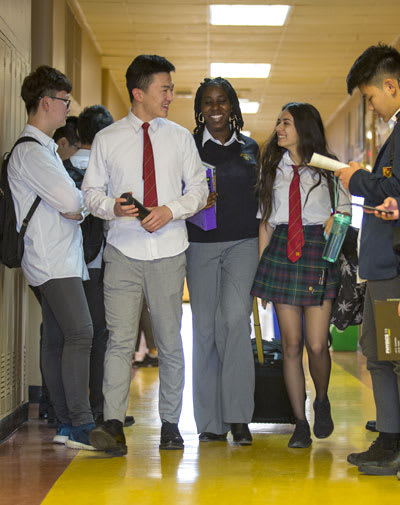
Athletics
Fieldstone is part of the Small Schools Athletic Federation (SSAF) and competes as the Fieldstone Grizzlies. The school has competed in basketball, volleyball, soccer, cross-country running, badminton, ball hockey, and golf. Students can also join house league teams and/or teams that compete against other private schools. In addition to house league intramural sports, most often held at lunchtime, the school engages in informal games that take place between Fieldstone teams and those of other schools with small student populations. Often these matchups are very informal, says Johnson, including pick-up games with area schools.
The options, to be sure, are broader and more varied than you’d expect of a school of this size. The facilities, too, are impressive, given the physical location of the school, among other things. There are full-sized fields on site and dedicated play areas for children in the earlier years.
All of that said, while there are many benefits to smaller student bodies—students are known, the faculty follow their progress through the grades, and the students enjoy being part of a close-knit community—athletics programs can be limited, something that Wong readily admits. The size of the student body, particularly in the primary and elementary years, naturally restricts the number of teams that the school can field in any given year. That’s less true of the high school grades, where the numbers are greater.
The focus within the teams, as is the case with all co-curriculars, is on participation and personal challenge. If a student is willing to make a commitment, they can participate on the team in some way. “We’ve had some cuts in the past,” says Johnson with candour. “That’s primarily when the student can’t keep up the commitment—perhaps they’ve taken on too many co-curricular activities or outside-school pursuits, so they don’t come to every, or at least most, of the practices.” She acknowledges the school’s approach may not be for everyone. “Some parents may like the inclusivity; other parents say, ‘well, it’s not a big deal when my child makes the team, because everyone makes it at Fieldstone.’ But I think it’s important that children have the opportunity to participate.” The goal throughout is to promote an active lifestyle and the social-emotional benefits of an active life.
Fieldstone has long had a Kilometre Running Club, and many of its members represent the school in charitable and other city-wide events. A number of students walk or run, and gather pledges, for the annual Terry Fox Run. In 2018, Fieldstone students, parents, teachers, and administrators fielded teams in the Toronto Marathon for the first time, hoping to start an annual tradition for the school. Not only were the Fieldstone students among the youngest participants, school administrators are of the opinion their team was the only parent/child collaboration in the entire race. They hope to inspire other schools and families to participate, and no doubt they will.
Co-Curriculars
Many of the co-curricular clubs are delivered by outside providers, for a reasonable fee. Administrators receive telephone calls and emails from a wide variety of providers looking to offer after-school clubs. Providers make presentations during school assemblies, and whether or not a particular club goes forward is based on student interest and subsequent parent signup.
Students can choose from a wide range of what are usually eight-week activities. Robotics and chess club are particularly popular; the chess club attracts many students who try to defeat the head of school during friendly matches. As well, teachers offer after-school or lunch-time clubs, based on their interests and skill sets. Generally included in tuition, these have ranged from arts and crafts to board game clubs.
Not surprisingly, many of the students who take to the Character Counts program are also keen to participate in the school’s service learning/outreach club programs. Offered to students in Grades 5 to 8, the emphasis is on hands-on, student-led initiatives. The club’s events are listed on a bulletin board in the main hallway and celebrated during school-wide assemblies. Many of the events are held at the school: Jump Rope for Heart to benefit the Heart & Stroke Foundation, and selling cupcakes (primarily homemade) during National Cupcake Day to benefit the local SPCA and Humane Society. During the year, the club hosts events (such as a Star Wars–themed day) to assist Fieldstone’s sister school, G.S. Marita, located in Cameroon, Africa. Each year, students participate in Me to We charitable initiatives and attend its gatherings.
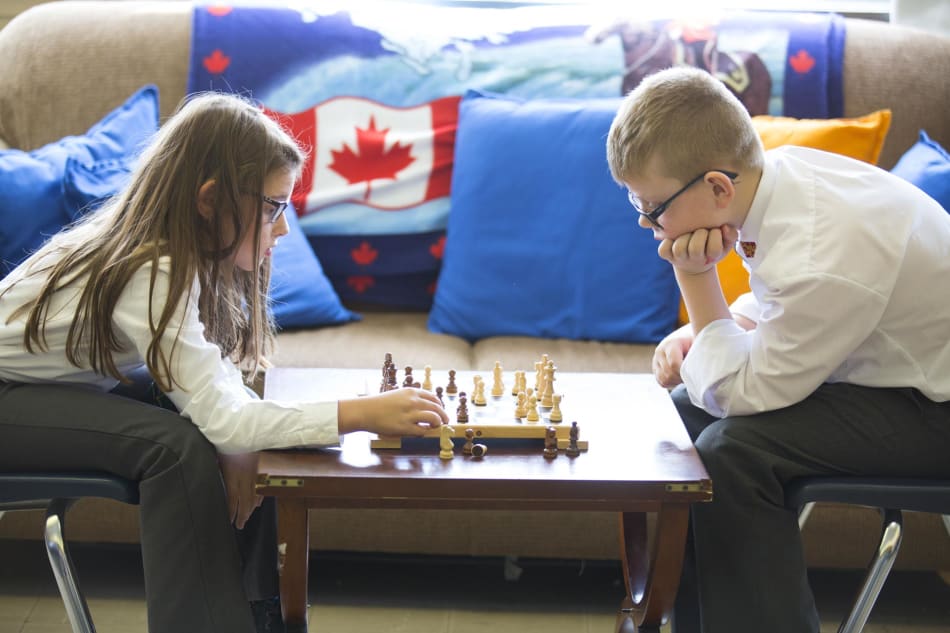
Pastoral care
Fieldstone does not have a formal guidance department; the small size of the student population allows teachers and administrators to be well versed as to each child’s activities. Most importantly, there is continued accountability, with teachers reporting on a regular basis on the progress made in achieving benchmarks.
Students meet in their houses each morning with teacher advisors. This time is used as a jump-start to the day, when teachers work with students as guides or coaches rather than instructors. By having structures in place where students and teachers can connect in different ways for different purposes, authentic mentor relationships can develop between teachers and students. These connections are viewed as the core of a caring and supportive foundation that gives students the courage to take risks and grow as people. A dedicated social-emotional counsellor offers workshops to the students as well as individual counselling, and Wong herself counsels secondary students on university placement.
There are no teaching aides in Fieldstone classrooms. Where required, the school’s resource teacher, in concert with parents, creates a student success plan. The school offers a withdrawal program for designated gifted learners during which time they work with the resource teacher on independent projects.
The school offers ESL for the students who need it.
Getting in
“My wife and I kept driving by and seeing the school banners along the fence on Dufferin Street,” says a current parent. “[We saw] the park setting and solid school building and we thought ‘wow! This looks just like a private school, the kind of place that we would want our children to go to...and it’s right in our neighbourhood.’” After scheduling a visit, he says, “the whole package came together for us and our kids—the curriculum, the teachers and admissions staff, the setting. Our instincts were right.”
We highly recommend a visit to the school to tour and see the facilities. It’s best to visit on a day when classes are in session, in order to get a sense of the daily life of the school. Prospective students are required to experience “a day in the life of a Fieldstone student” before an offer of admission will be considered. During the day, the child is fully immersed in house, academic, sports, and co-curricular activities. One parent says that, for some students, this can be overwhelming, and “Fieldstone staff is sensitive to this reality.” When his son spent a full day at the school, “he was sick and also quite nervous, and came across in no way as the child he truly is.” When admissions staff were informed, they scheduled a second visit, and subsequently offered a place to his son, who now “absolutely loves the school, although he took a bit of time to settle in,” he says.
From its very beginning in the church basement, Butcher’s view—which is still central to the admissions process—has been this: “at Fieldstone we see not the child we meet, but rather who that child will become.” Fieldstone looks for families who believe in a community approach to education—who embrace the philosophy that the administration, teacher, student, and parent all have a role to play to ensure a happy and productive learning environment.
All students and their families visit the school for regular tour days, and are introduced to Fieldstone’s unique Cambridge-Ontario curriculum and school philosophy, including the school’s approach to education, arts, music, sports, and co-curriculars. There’s a presentation by the head of school and informal meetings with admissions personnel and teachers. Depending on their schedules, specialty teachers in French, music, and arts are often available to meet with prospective parents and students.
Thereafter, interested families are asked to complete an online admission form. Students are assessed by the metrics common to most private schools. As would be expected, the assessment process includes report cards from the most recent two years and information on the student’s co-curricular activities. All students write an academic assessment based upon the grade the child will be entering.
Academic potential is more valued at Fieldstone than prior academic achievement. Administrators look for students who are eager to learn, to explore, and to grow. Students of all ability thrive at Fieldstone, but it is the students who embrace challenge with the willingness to learn something new who really benefit from the program. Parents are drawn by the rigour of the program, as well as its focus on core knowledge. The Cambridge Assessment, too, is a draw, in that it lends an objectivity and transferability to the results, and that it is an international standard recognized throughout North America and even more in Europe.
“We welcome students who will embrace our culture and work to be part of our community,” says Johnson. Most students enter in September or January; however, the school’s rolling admission ensures that, in certain circumstances, students are able to transfer into Fieldstone at other times in the school year. The school has developed a process to help mid-year entry students successfully integrate into their grade, their house, and their chosen co-curricular activities.
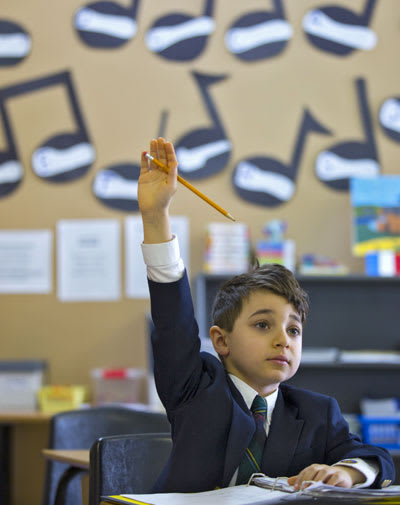
Money matters
The cost of tuition covers all instruction and activities associated with the core program. There are some further costs, including bus transportation (if required), school uniforms, and any fees associated with field trips and co-curricular activities.
The cost of field trips is minimal (if there is a cost at all): depending on the grade, these curriculum-linked trips are to local spots such as the Royal Ontario Museum, Ontario Legislature, Toronto Botanical Gardens, and Black Creek Pioneer Village. During Horizons Week, which is held yearly in May, Fieldstone offers group trips to cities such as Ottawa or Montreal, or students can choose to be part of an outdoor education trip to areas north of Toronto.
Financial assistance is available through both scholarships and bursaries, with applications available through Apple Financial Services. Payment plans are available, including quarterly and monthly arrangements.
Parents and alumni
Communication with parents is frequent and detailed. Fieldstone is committed to a team approach that links students, parents, teachers, and administration. Parents report that email and phone messages are responded to quickly. There’s a Safe Arrival program, and parents of unaccounted-for students are contacted promptly by the office.
Every week, parents receive the Friday File e-newsletter, which brings them up-to-date on both school-wide and grade-specific activities. Teachers also send weekly updates. As is appropriate for a school that puts emphasis on teaching traditional skills such as cursive writing, each student is issued a pen-and-paper agenda in which to record activities, homework, and tests, and serves as a further communication tool between homeroom teachers and parents.
Parental involvement is welcomed and many parents volunteer in a variety of capacities, including as class parents, on field trips, and helping to set up school-wide activities such as the spring concert, winter concert, and Shakespeare Night. A number of parents are active with the Fieldstone Parents Association (FPA), which holds pizza lunches and other events, such as renting an ice cream truck for the last day of school. The Fieldstone Alumni Association (FAA) holds regular meetings, and members attend events at the school, including concerts, athletic events, plays, and science fairs.
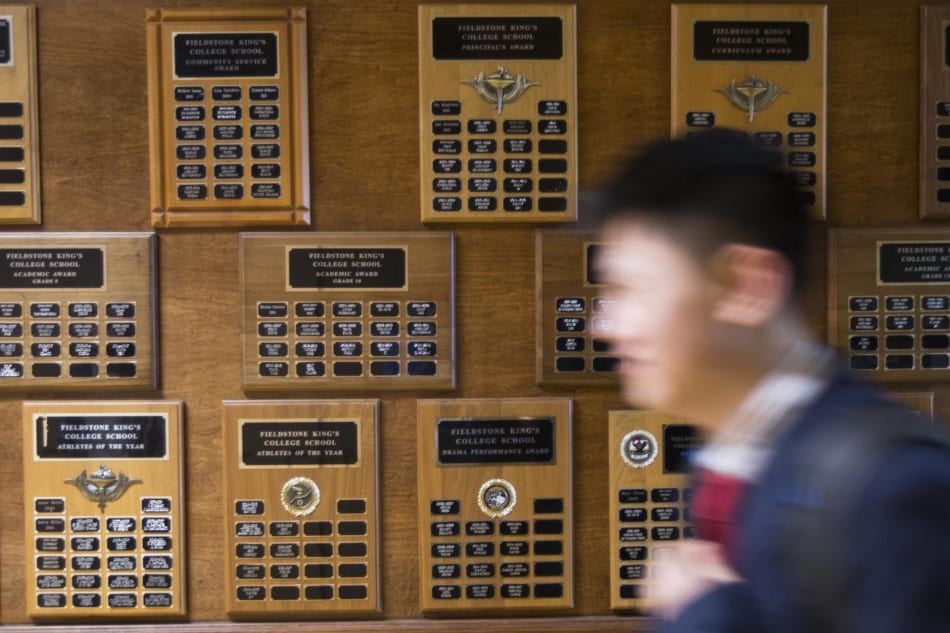
The takeaway
While every school is one of a kind, Fieldstone is more unique than most. To date, it has been rare to see an institution fully given over to a program based on canonical or core knowledge. While core knowledge is gaining some traction in the UK, in Canada it’s most typically used in concert with other forms of delivery, or used only in certain subject areas, such as social studies. At Fieldstone, it provides a compelling backbone for program delivery across the grades and across disciplines. Adoption of the Cambridge Assessment, too, is rare, as is the development of a completely tailored, ground-up curriculum based on a conviction of how best to address the needs of a certain kind of learner.
Just as Butcher was drawn to the work of E. D. Hirsch, instructors who teach at Fieldstone are drawn by a sense that there is a better way to do things. Everyone is aligned in their vision of what an elementary school education should entail in order to ensure students have the knowledge they will need to be successful leaders in the future. “Everyone is working towards a common goal and is on the same page,” says a parent. “And that same page is, you know, what’s in the best interest of their child. I feel it’s a true community.”
The aim is to provide an inclusive, supportive, 360-degree student experience, and both curricular and extra-curricular programs have been created with that goal in mind. Class sizes are kept small, and the relationships between instructors, administrators, and students is close. The feel is nurturing, yet the academic gaze is wide. The intention at Fieldstone is to educate students to positions of informed leadership, both locally and globally.







